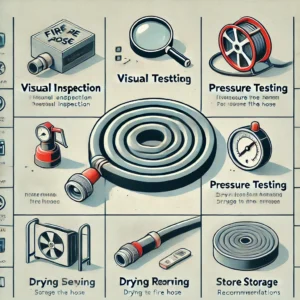Fire Hoses Testing: A Detailed Overview
Fire hoses are critical safety devices that require routine inspection to guarantee they function appropriately in emergencies. Neglecting this important maintenance can result in extreme repercussions during a fire. This overview offers a detailed, SEO-optimized treatment for checking fire hoses. Whether you’re liable for a property, industrial, or industrial home, these steps will certainly aid you in preserving safety and conformity.
Why Fire Hose Inspections Are Important

how to check fire hoses
Fire hoses are exposed to wear and tear, ecological factors, and aging. Normal checks help determine:
- Leakages or HOLES
- Kinks or twists
- Degeneration of materials
- Blockages or obstructions
- Combining or nozzle breakdowns
Following local fire safety and security guidelines
Commonly mandates regular assessments and testing. Appropriate upkeep lessens failing dangers and ensures preparedness throughout emergencies.
- Devices and Materials Needed
- Before starting, collect the following:
- Fire hose pressure scale
- Clean water resource
- Examination log
- Flashlight
- Wrench or spanner (for Coupling).
- Safety gloves and glasses.
- Cleansing towel.
Step-by-Step Procedure for Fire Hose Testing.

Step-by-Step Procedure for Checking Fire Hoses.
Action 1:
Visual Inspection.
Take A Look At the Outer Surface:
- Inspect the entire length of the tube for cuts, abrasions, leaks, or various other visible damage.
- Seek staining or cracking, which might show aging or exposure to dangerous compounds.
Inspect the Couplings:
- Ensure the couplings are safely connected, without corrosion, and have no damages or bending.
Evaluate the Nozzle:
- Verify that the nozzle is tidy and functional. Look for blockages or signs of damage.
Check Out Labels and Markings:
- Confirm that the pipe tags (if any) are legible, as they frequently indicate essential information like stress ratings.
Action 2:
Conduct a Hose Unroll Test.
- Totally unroll the hose to check for twists, spins, or flattening.
- Lay it flat on a clean surface area, ensuring there are no sharp things beneath that could cause damage.
Action 3:
Perform a Pressure Test.
Connect the Hose:
- Attach the hose to a reliable water source or pump.
Rise Pressure Gradually:
- Slowly boost water pressure to the hose pipe’s rated capability. This imitates real use problems.
Monitor for Leaks:
- Observe the whole length of the hose pipe for leakages, protrudes, or vulnerable points.
Evaluate the Nozzle:
- Operate the nozzle to ensure it provides a constant spray pattern without obstructions or irregularities.
Read About: Air Hose
Action 4:
Clean the Hose.
- Rinse with Clean Water: Remove dirt, crud, or residues that could deteriorate the product.
Dry Thoroughly:
- Ensure the hose is entirely dry prior to storage to stop mould or mould growth.
Action 5:
Record Findings.
Log Inspection Details:
Record:
- Date of assessment.
- Any flaws discovered.
- Repair work done.
- Following the scheduled assessment day.
- Make use of a standardized inspection checklist to guarantee uniformity and compliance.
Action 6:
Repair or Replace if Necessary.
Minor Repairs:
- Small leaks or damaged gaskets can commonly be fixed on-site with appropriate tools.
Change When Required:
- If the hose pipe has significant damage or falls short of the pressure test, change it promptly to avoid risks.
Typical Problems and Solutions.
1. Leaks:
- Patch small leaks making use of repair work packages or replace severely damaged areas.
2. Mold and mildew or Mildew:
- Clean the hose pipe with a mild detergent and ensure thorough drying.
3. Rigid Couplings:
- Apply lubricating substance to the combinings for smoother operation.
4. Nozzle Blockages:
- Remove the nozzle and tidy it completely.
Fire Hose Maintenance Tips.

maintenance tips for fire hose
- Regular Schedule: Inspect fire hoses at least every year or a lot more frequently for high-risk atmospheres.
- Appropriate Storage: Store hoses in a completely dry, well-ventilated area away from direct sunshine or extreme chemicals.
- Training: Ensure personnel dealing with fire hoses are learnt correct inspection and maintenance treatments.
- Usage Hose Racks: Use tube shelves or reels to prevent kinks and damage.
Frequently Asked Questions About Fire Hose Inspections.
Q: How often should fire hoses be evaluated?
A: Fire hoses need to be visually inspected regularly monthly and pressure tested every year or as required by neighbourhood fire safety and security codes.
Q: What should I do if my fire hose stops working the stress test?
A: Immediately remove the hose from service and change it. For small problems, speak with a professional repair work solution.
Q: Can I do examinations myself, or do I need a specialist?
A: While fundamental inspections can be done by skilled personnel, annual stress examinations must be done by qualified specialists to ensure compliance with safety standards.
Conclusion:
Regularly evaluating fire hoses is an essential part of fire safety and security that ensures their reliability and performance throughout emergencies. By following this detailed guide, you can identify and address problems early, ensuring your fire hoses stay an ideal problem. Keep in mind that safety and security constantly come first, and proactive upkeep can conserve lives.
Carry out these treatments today to maintain safety and comply with regulations. For even more understanding and safety and security tips, discover added resources ablaze security equipment.
One Response